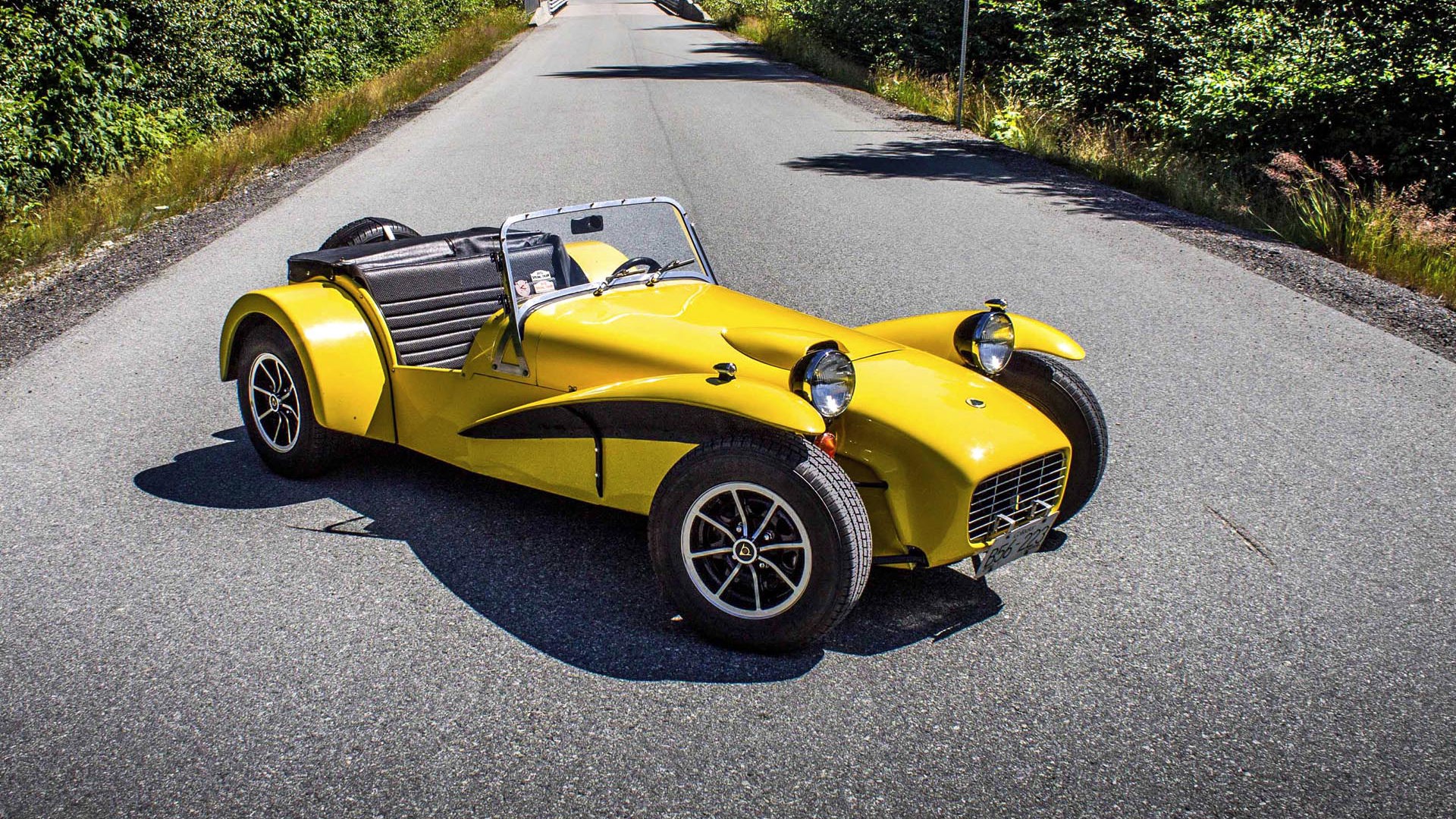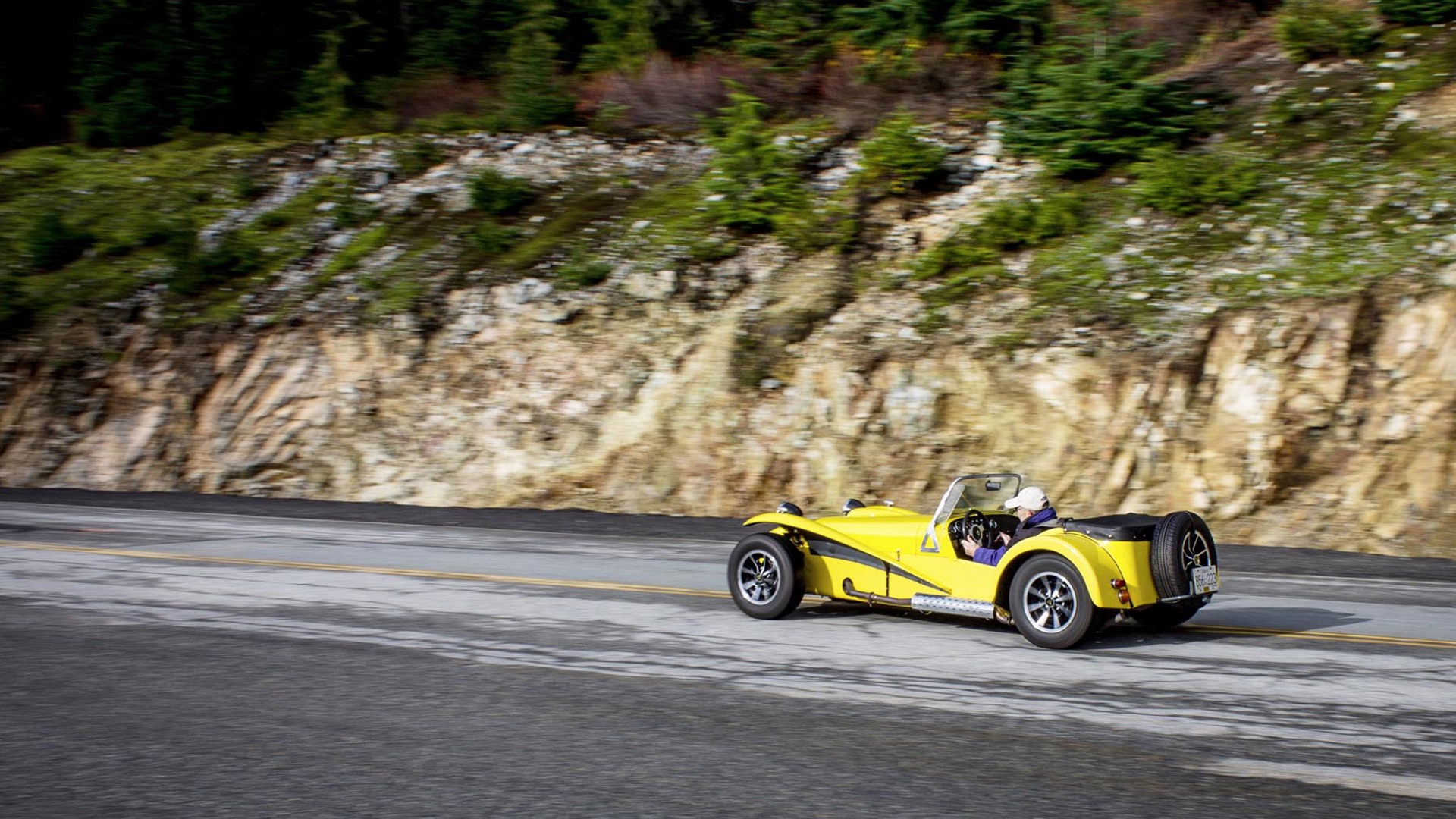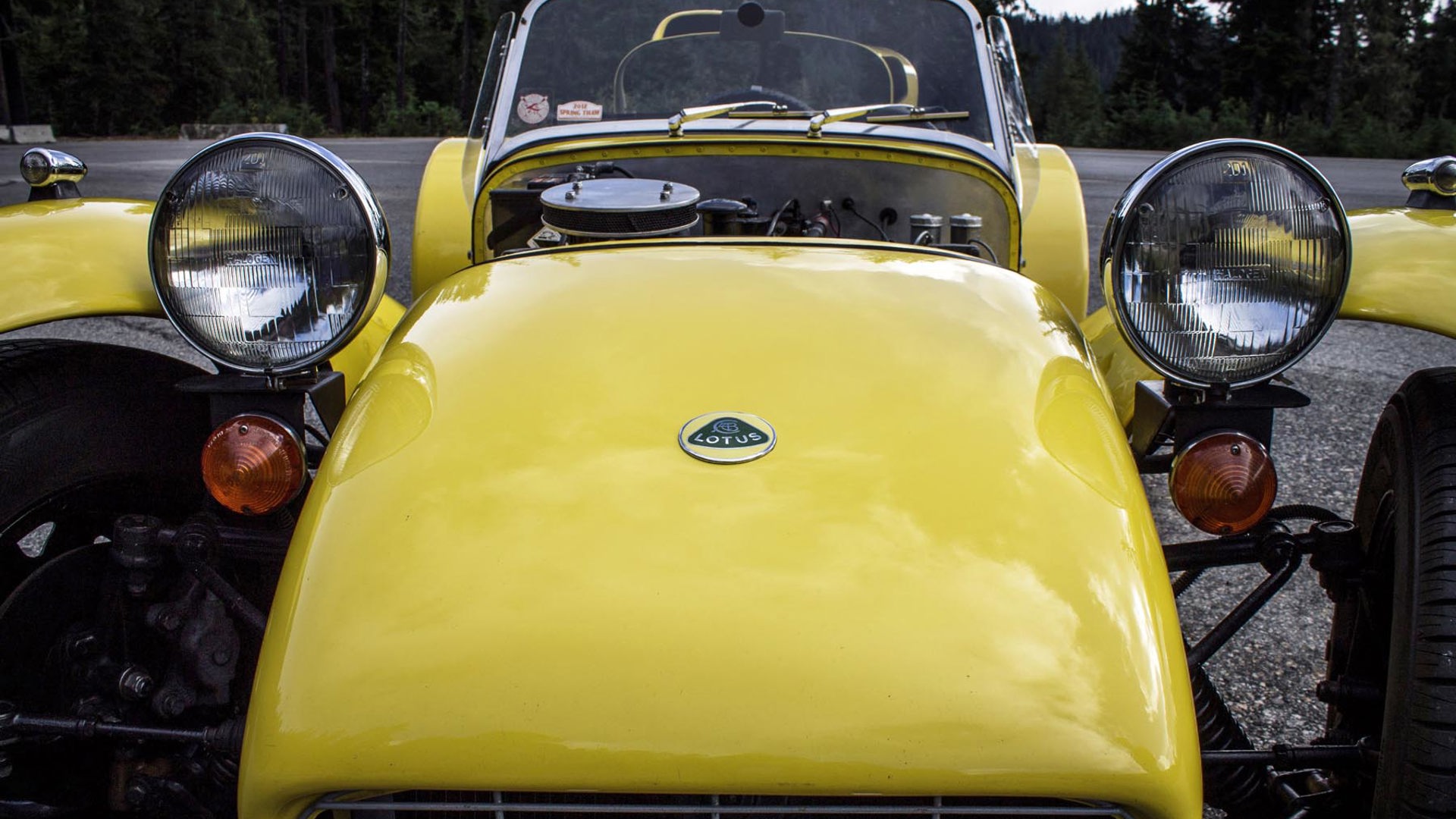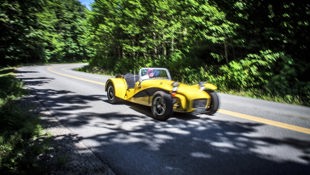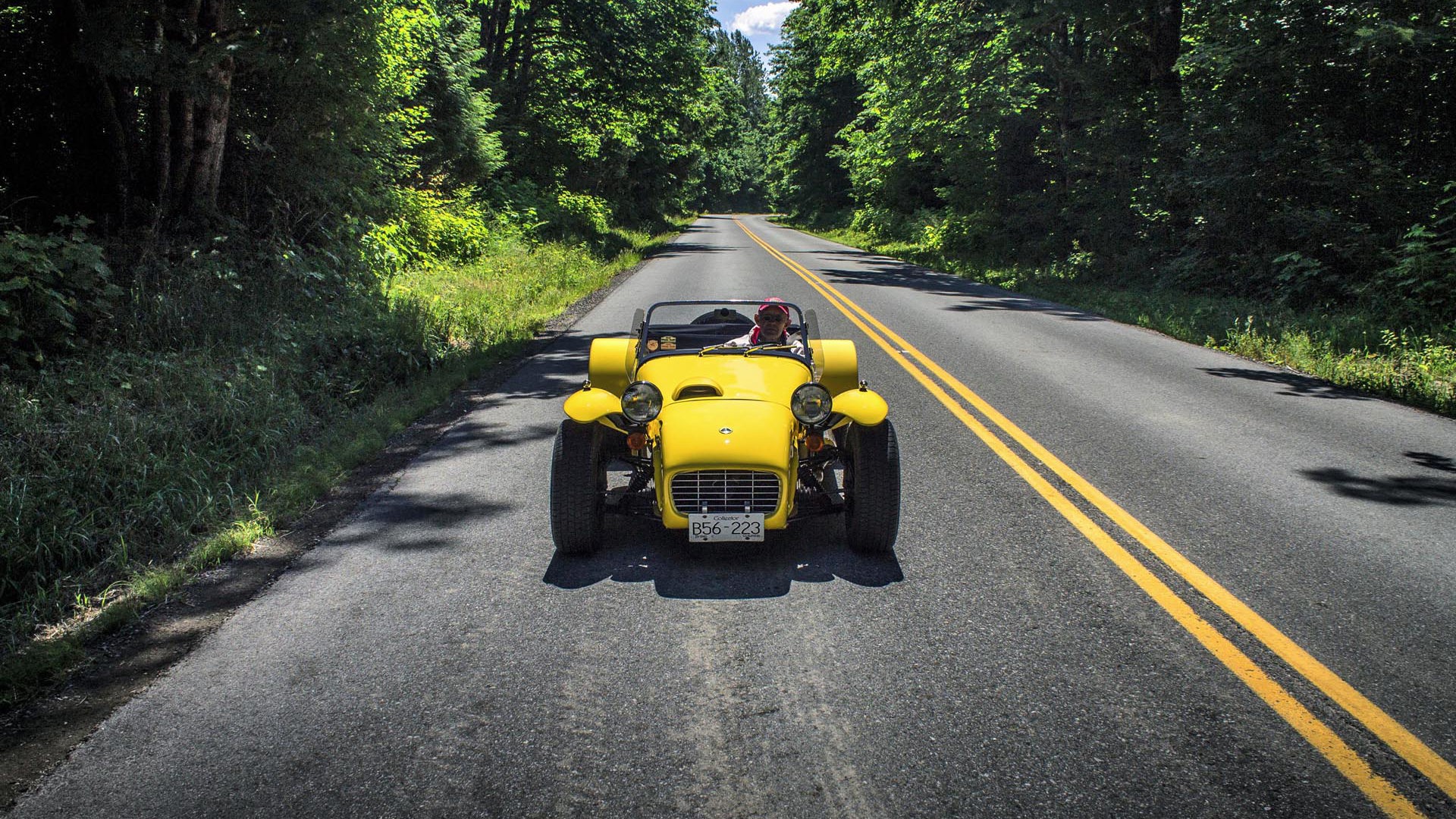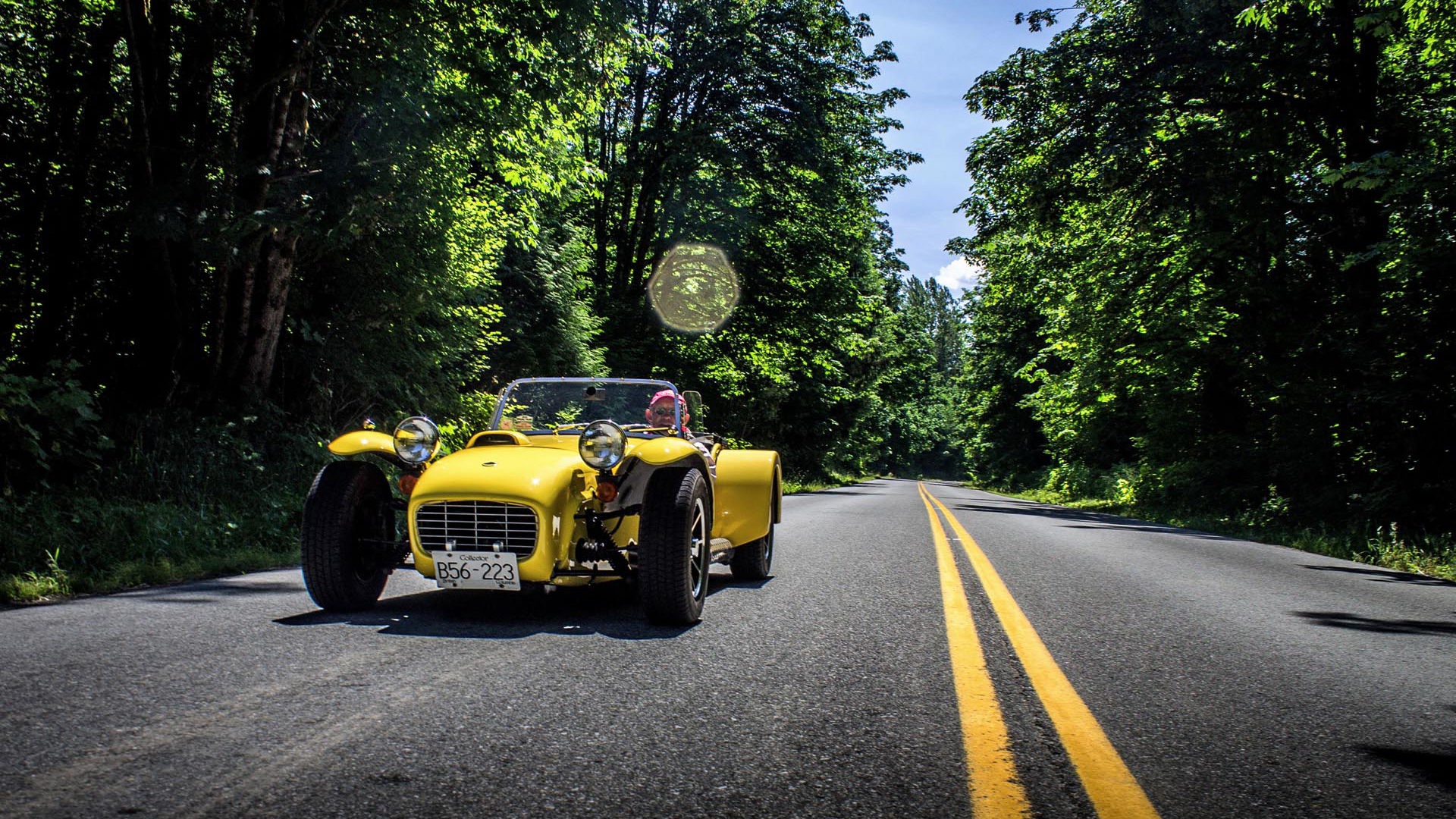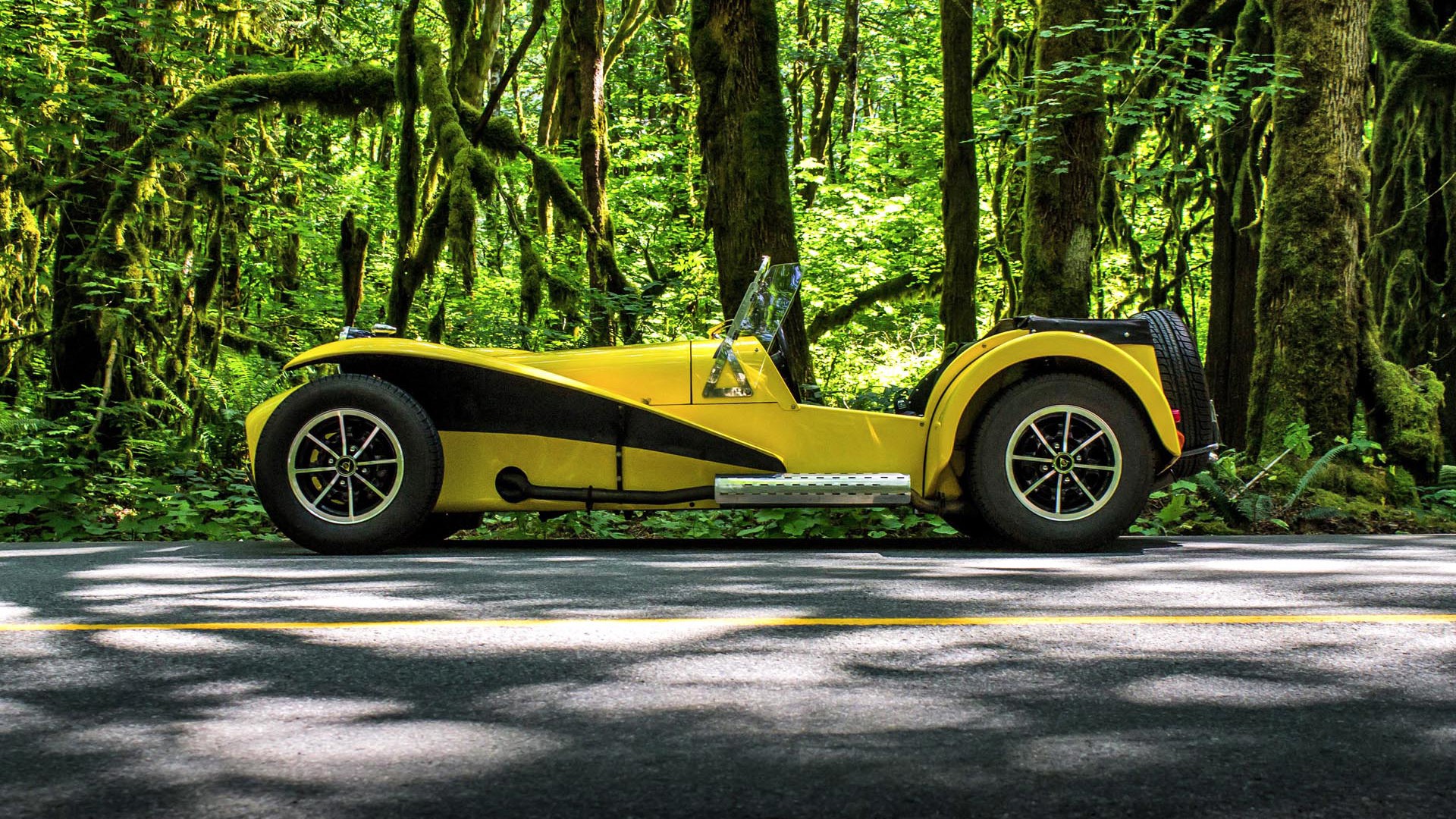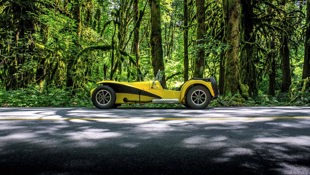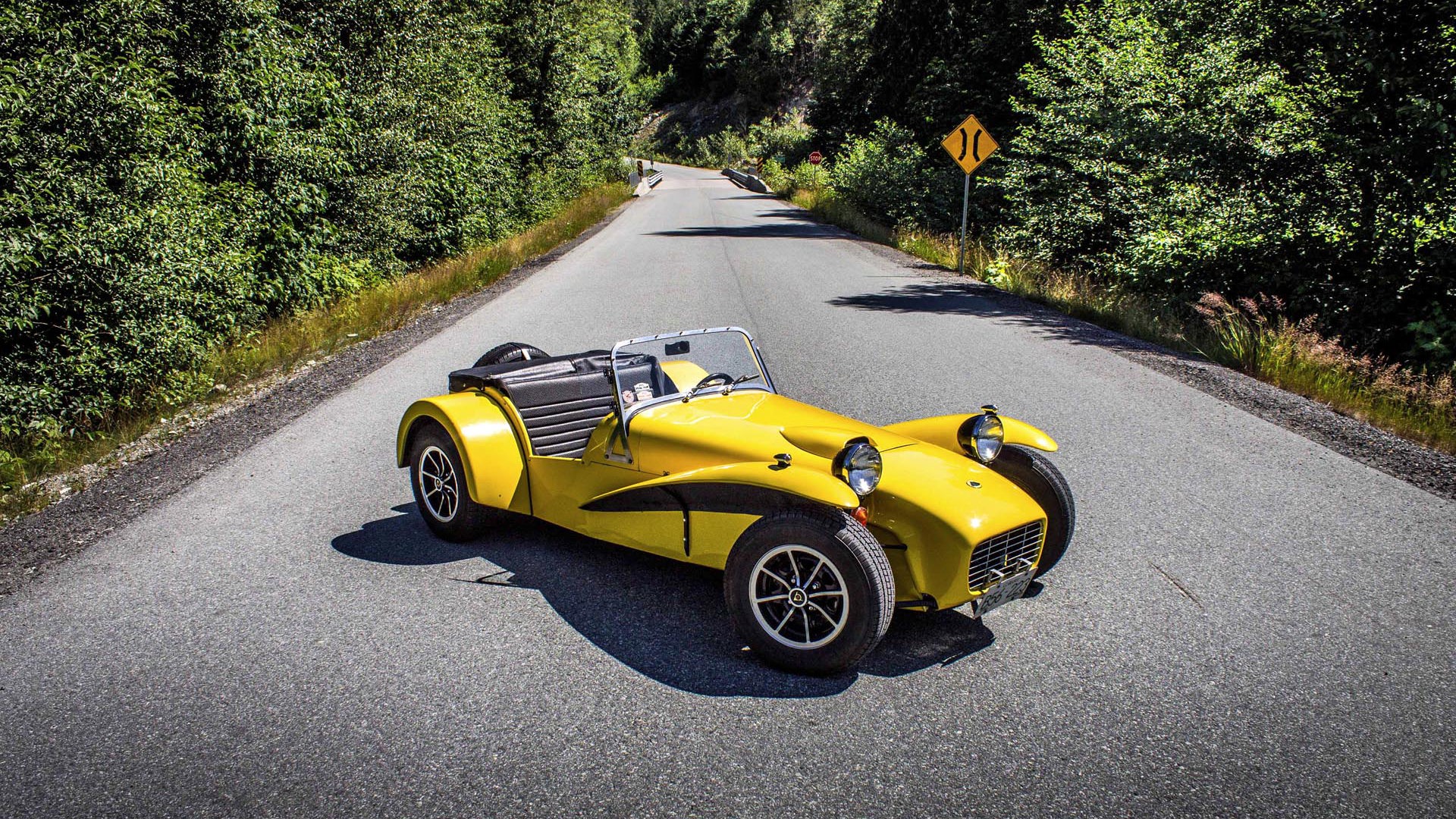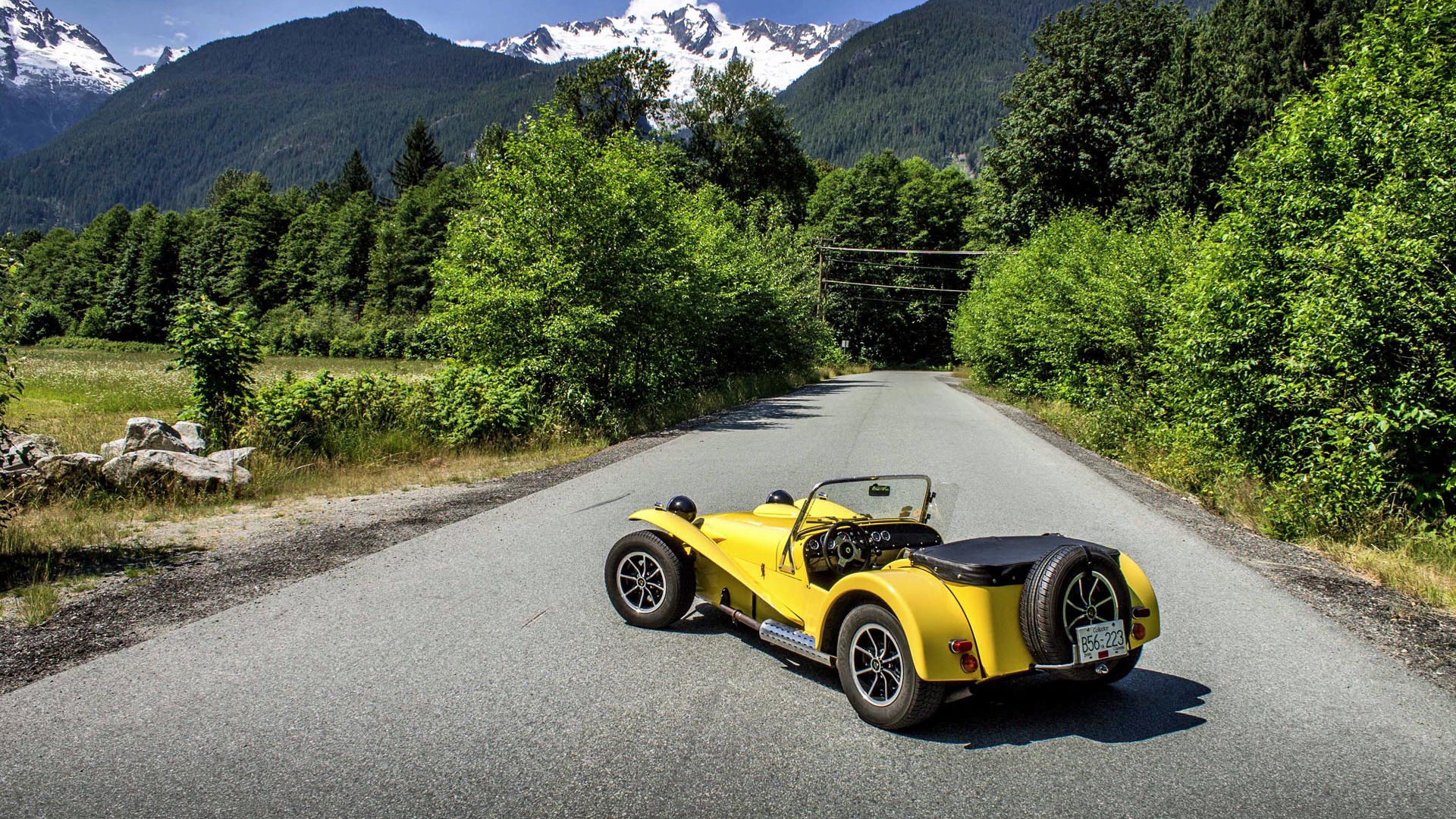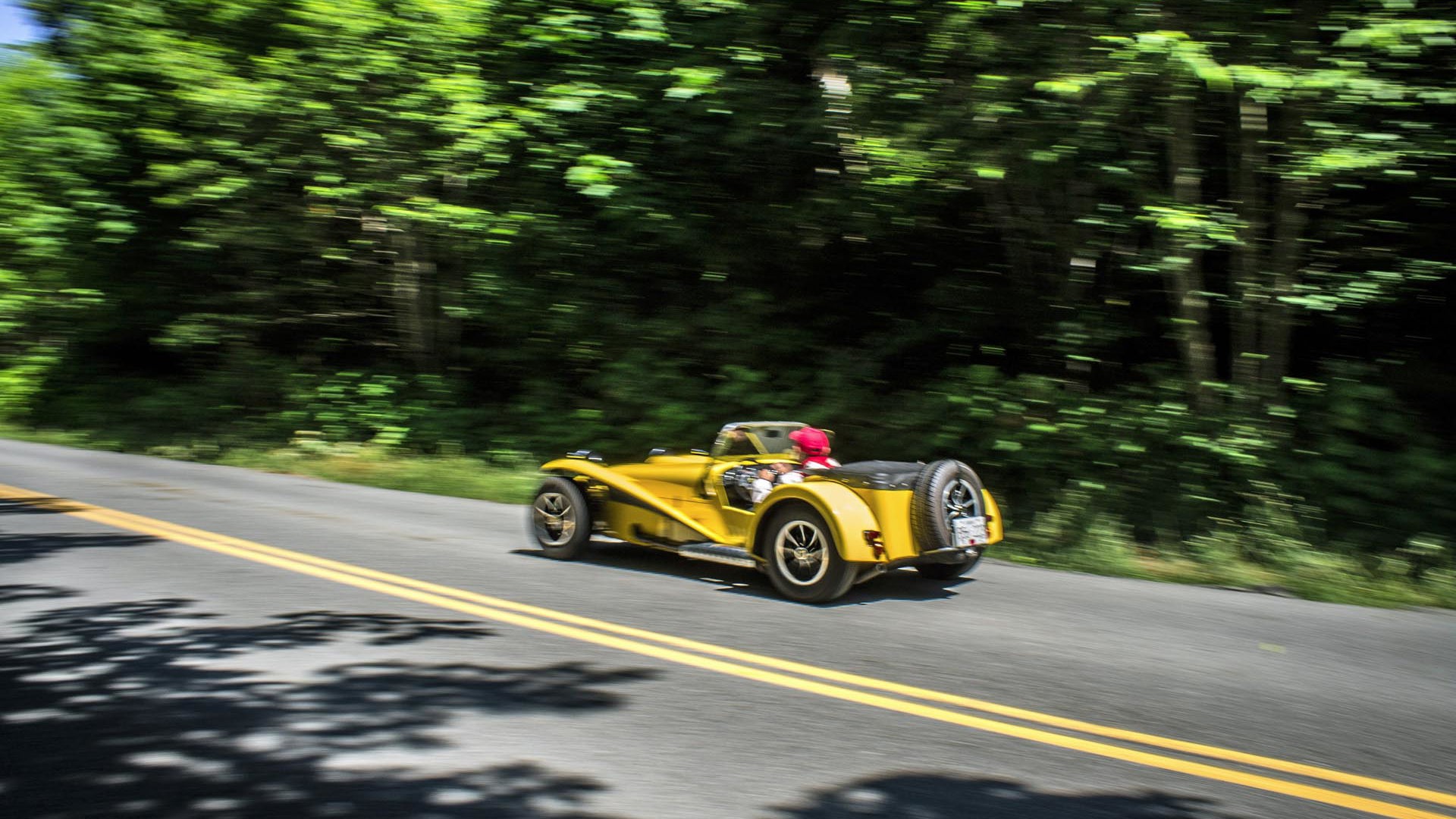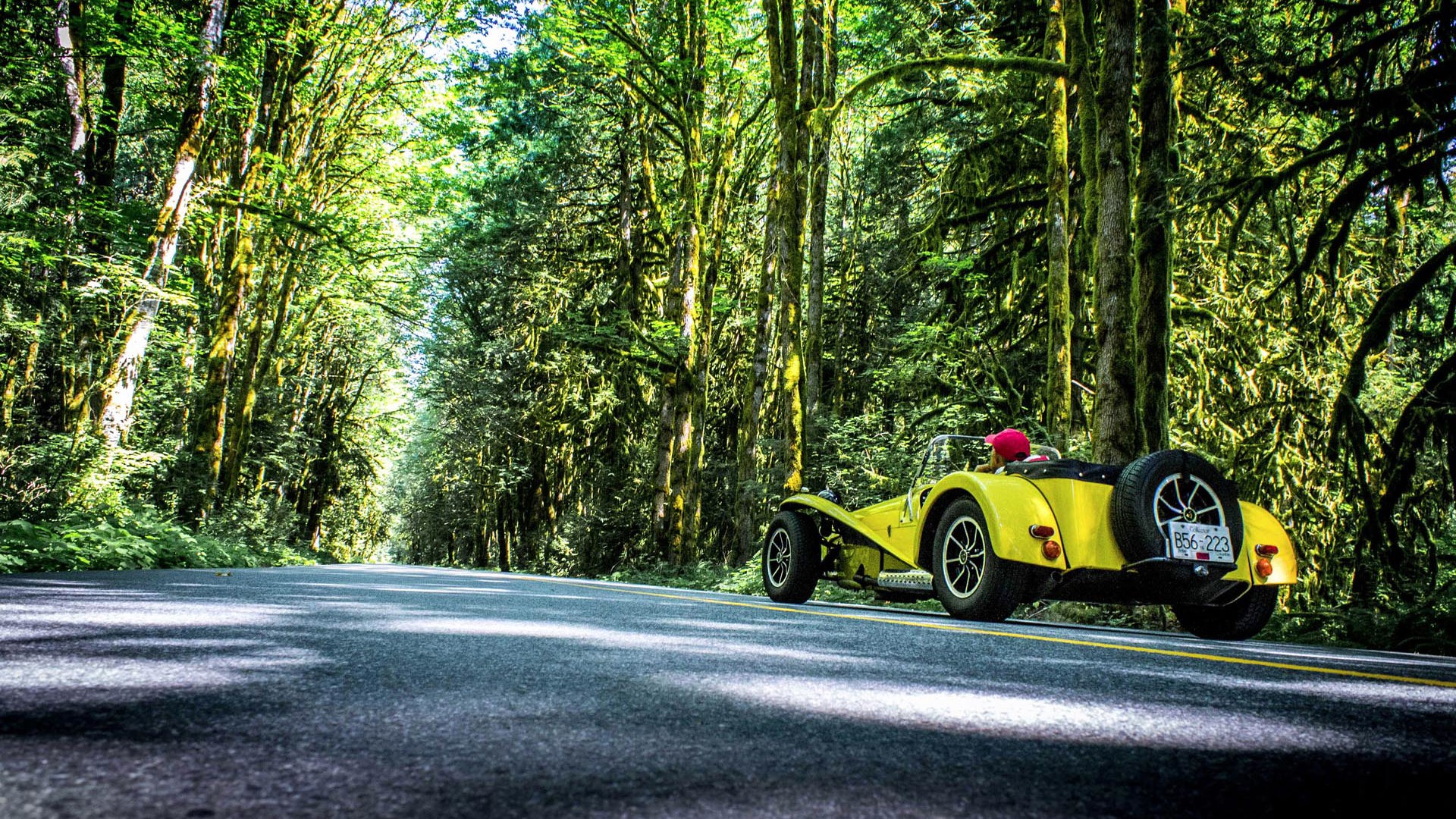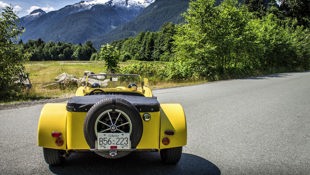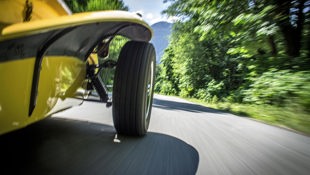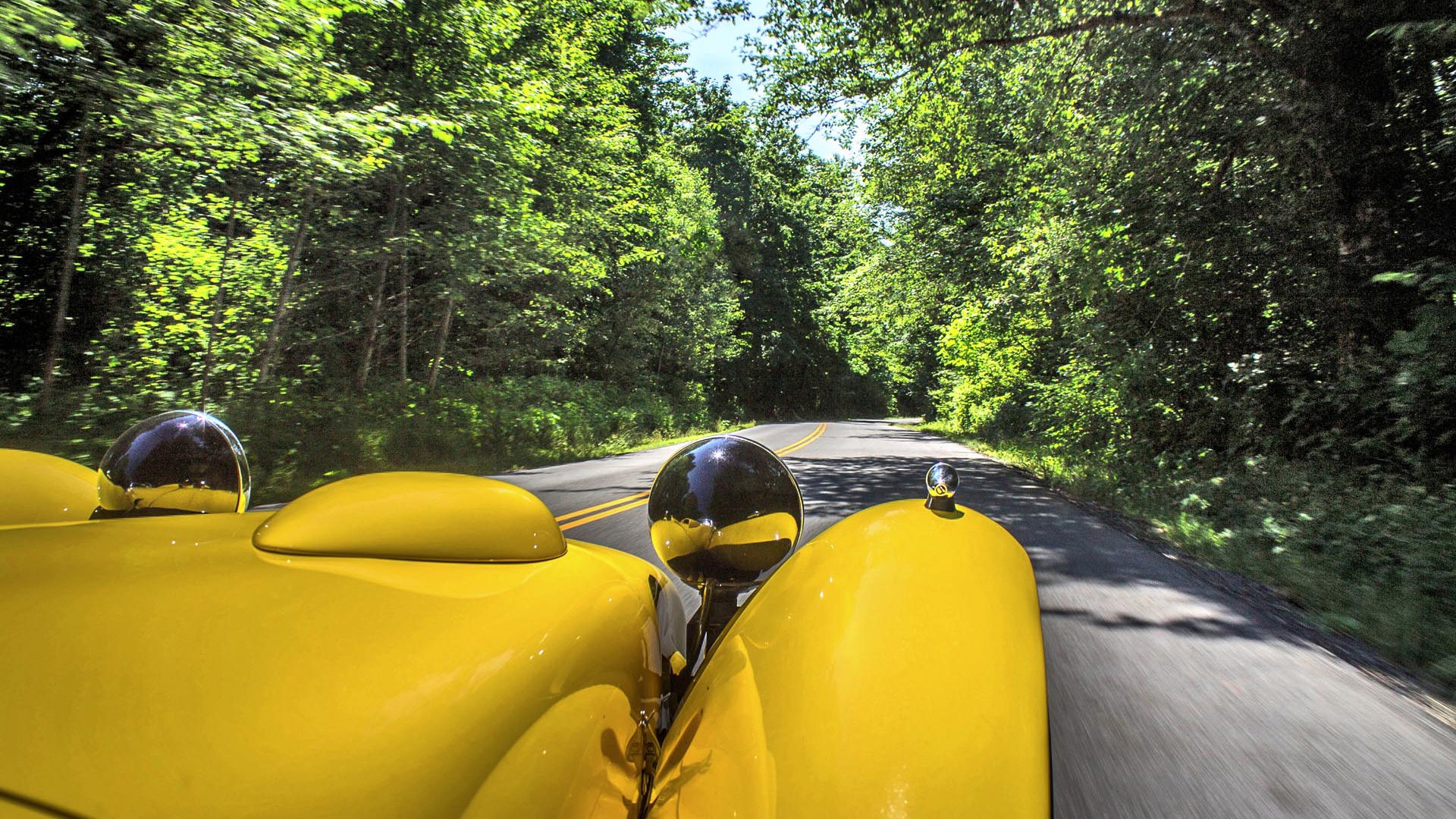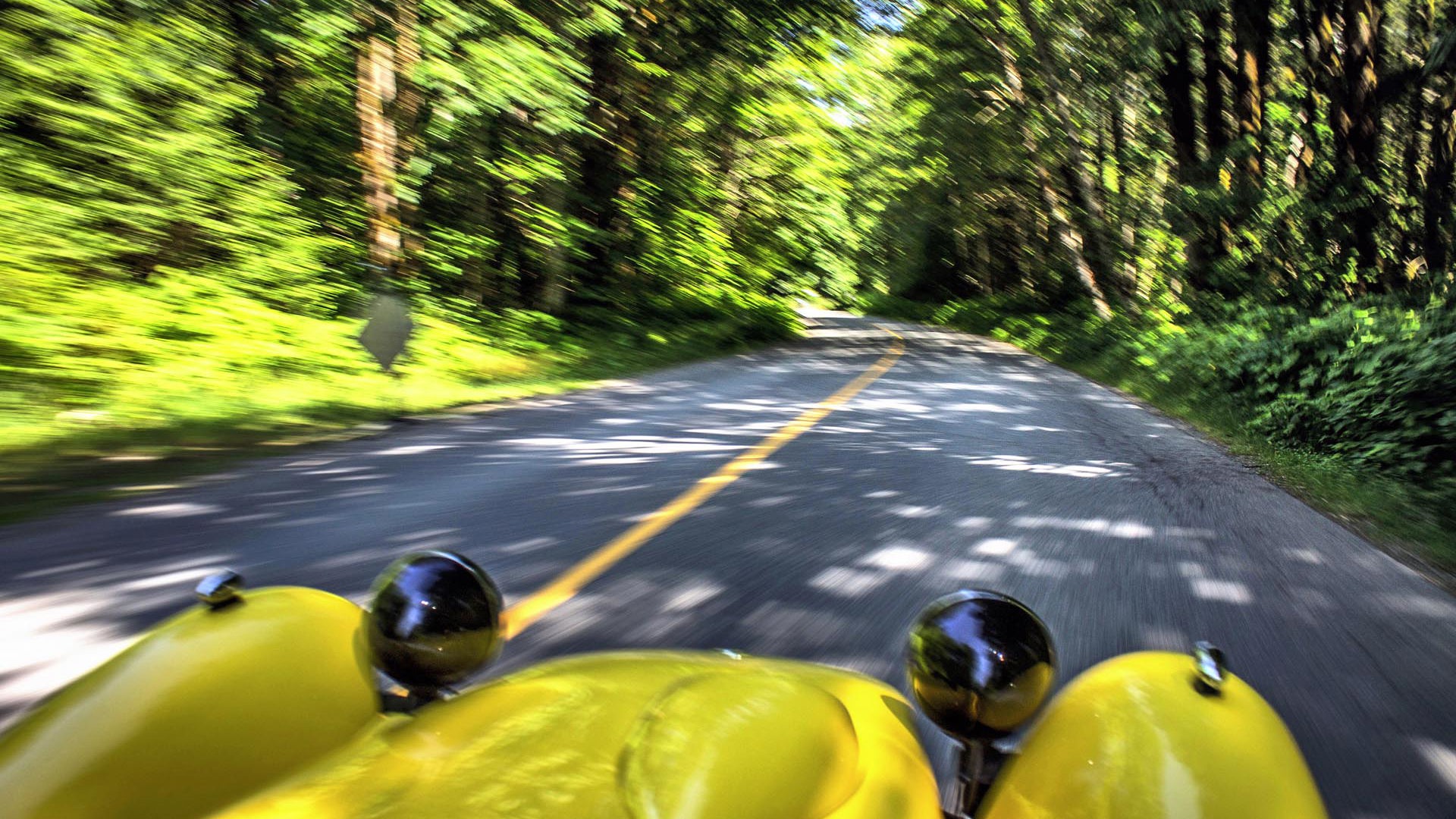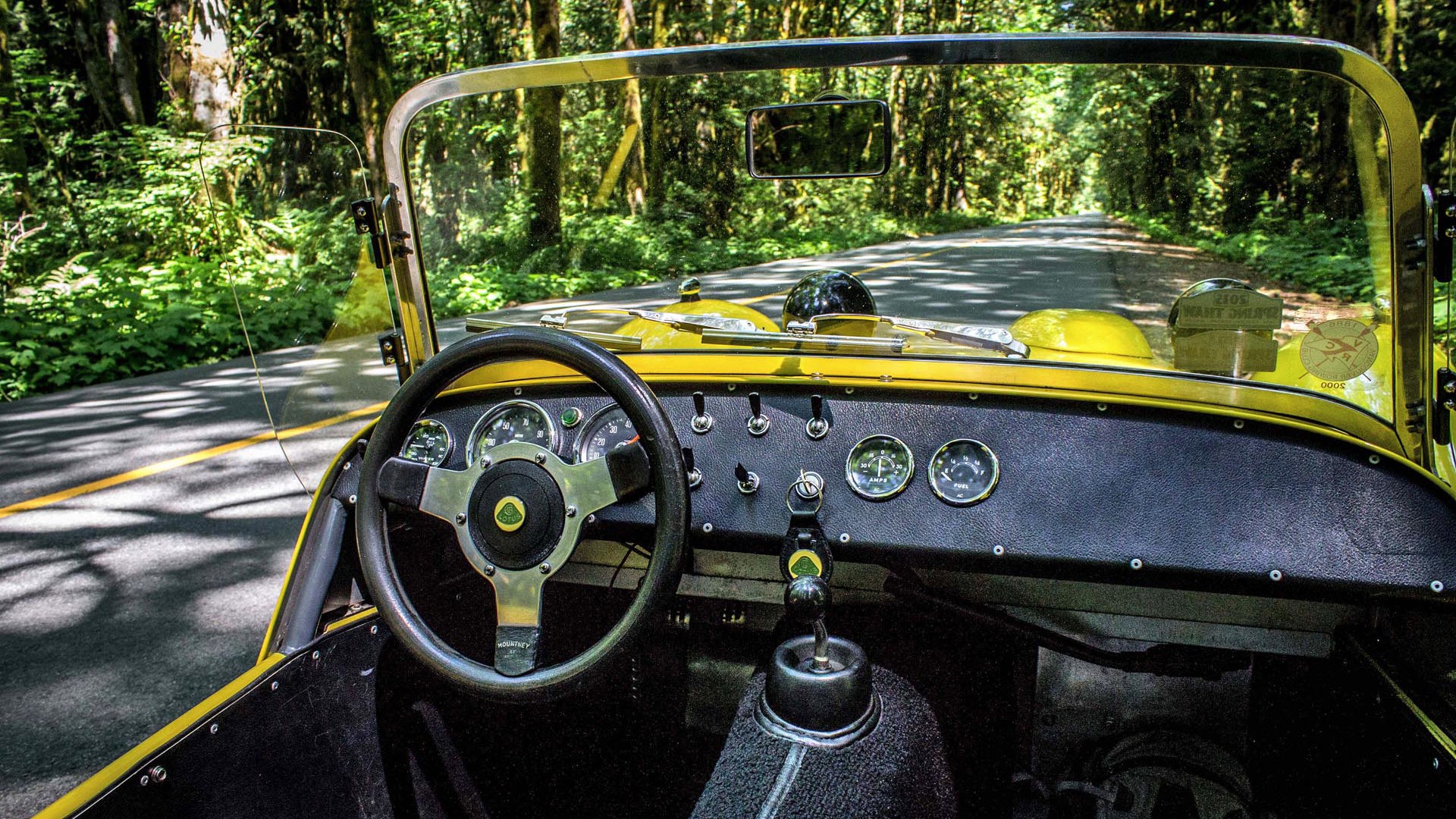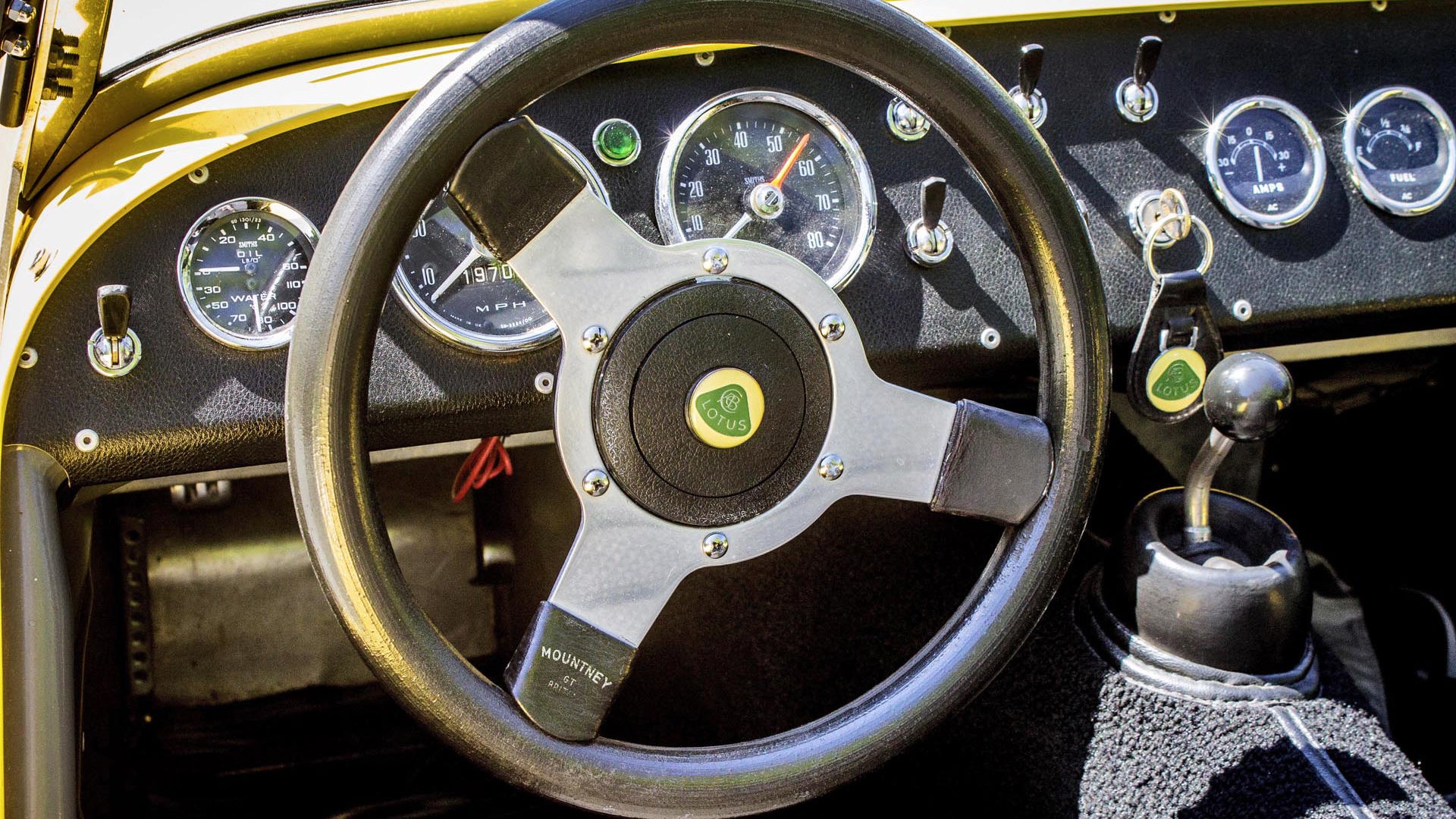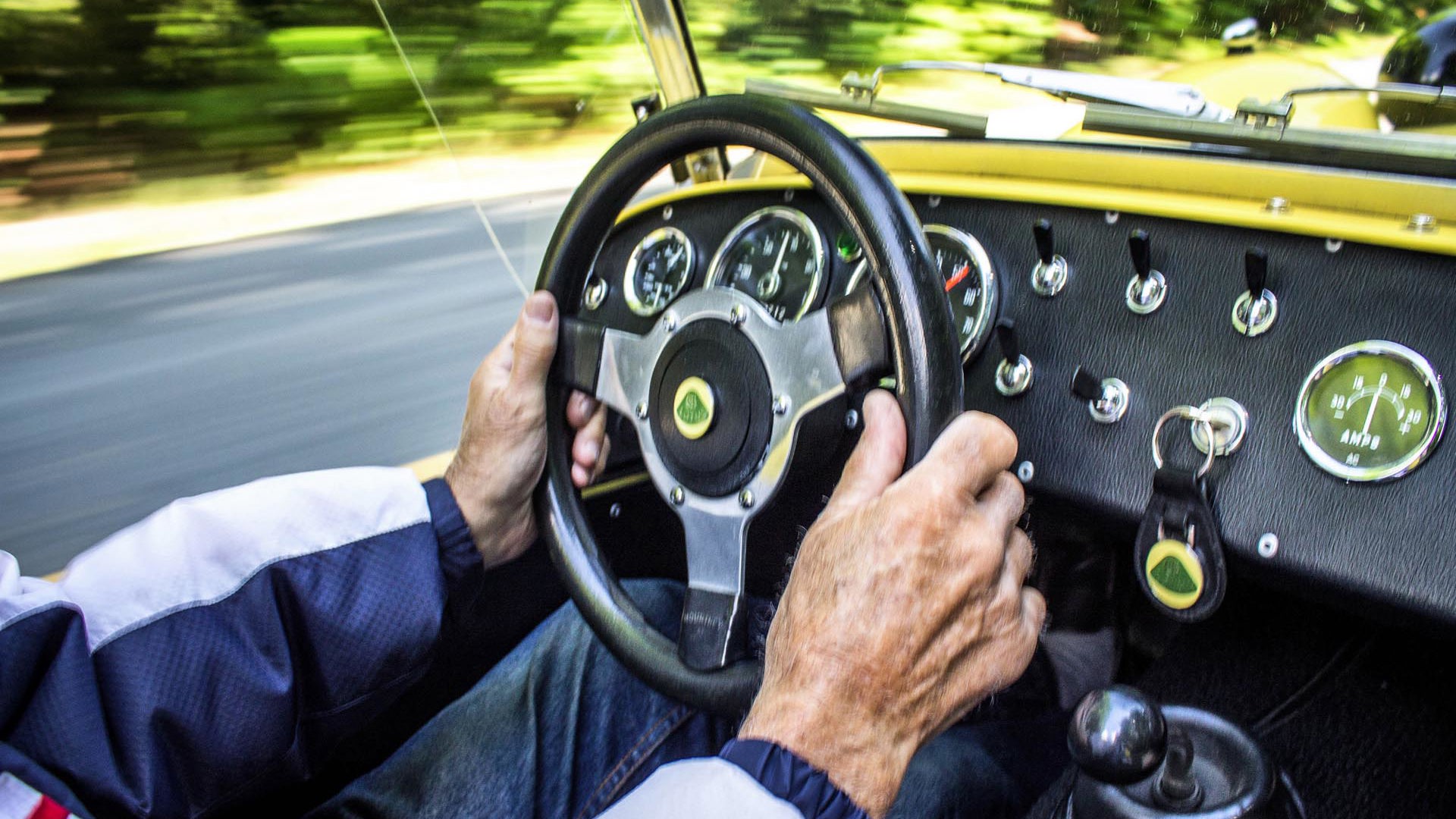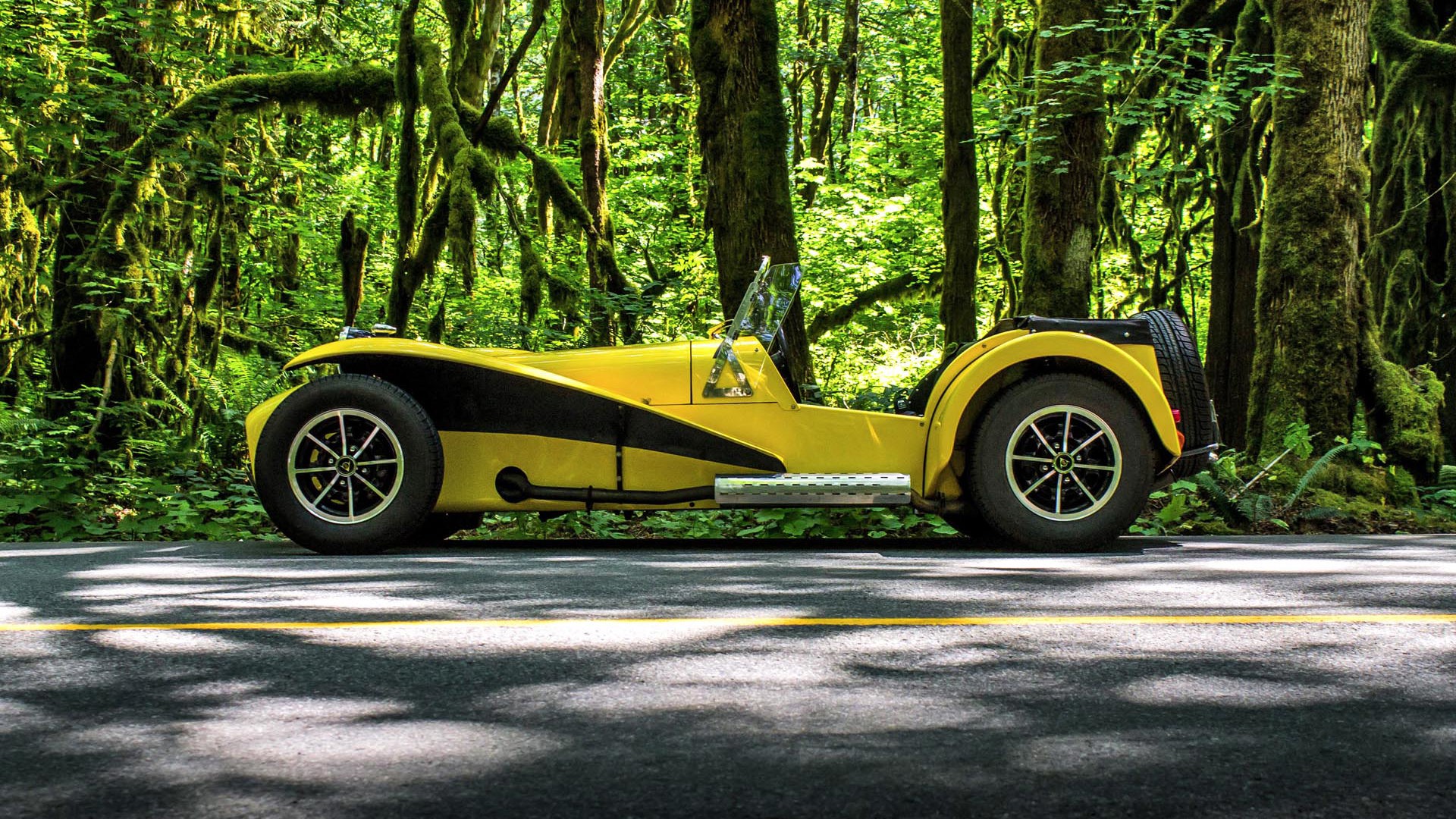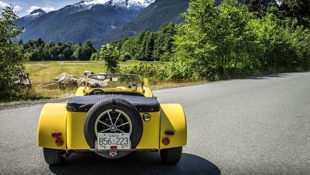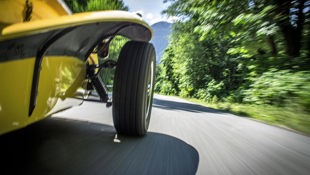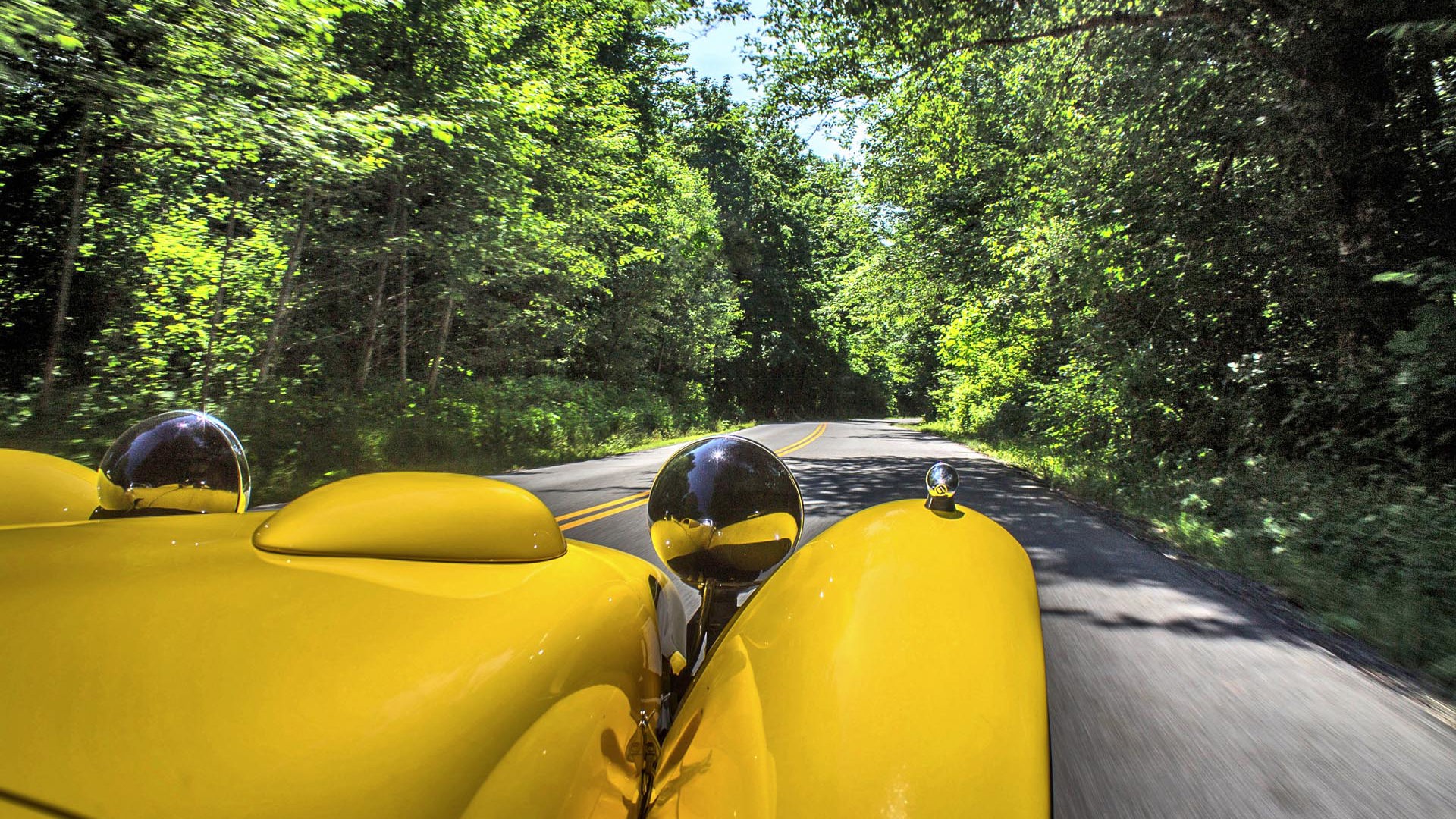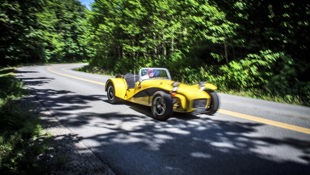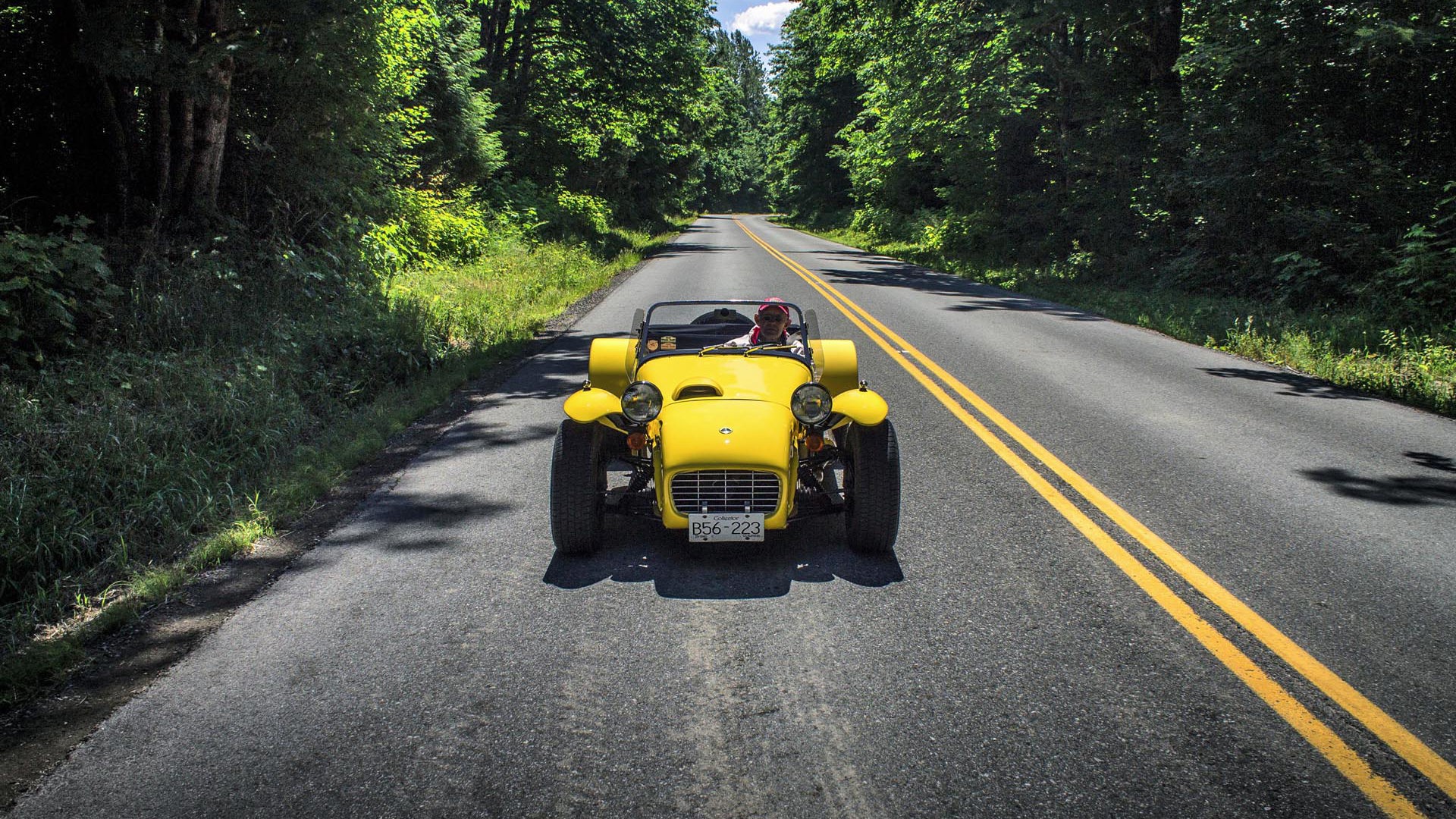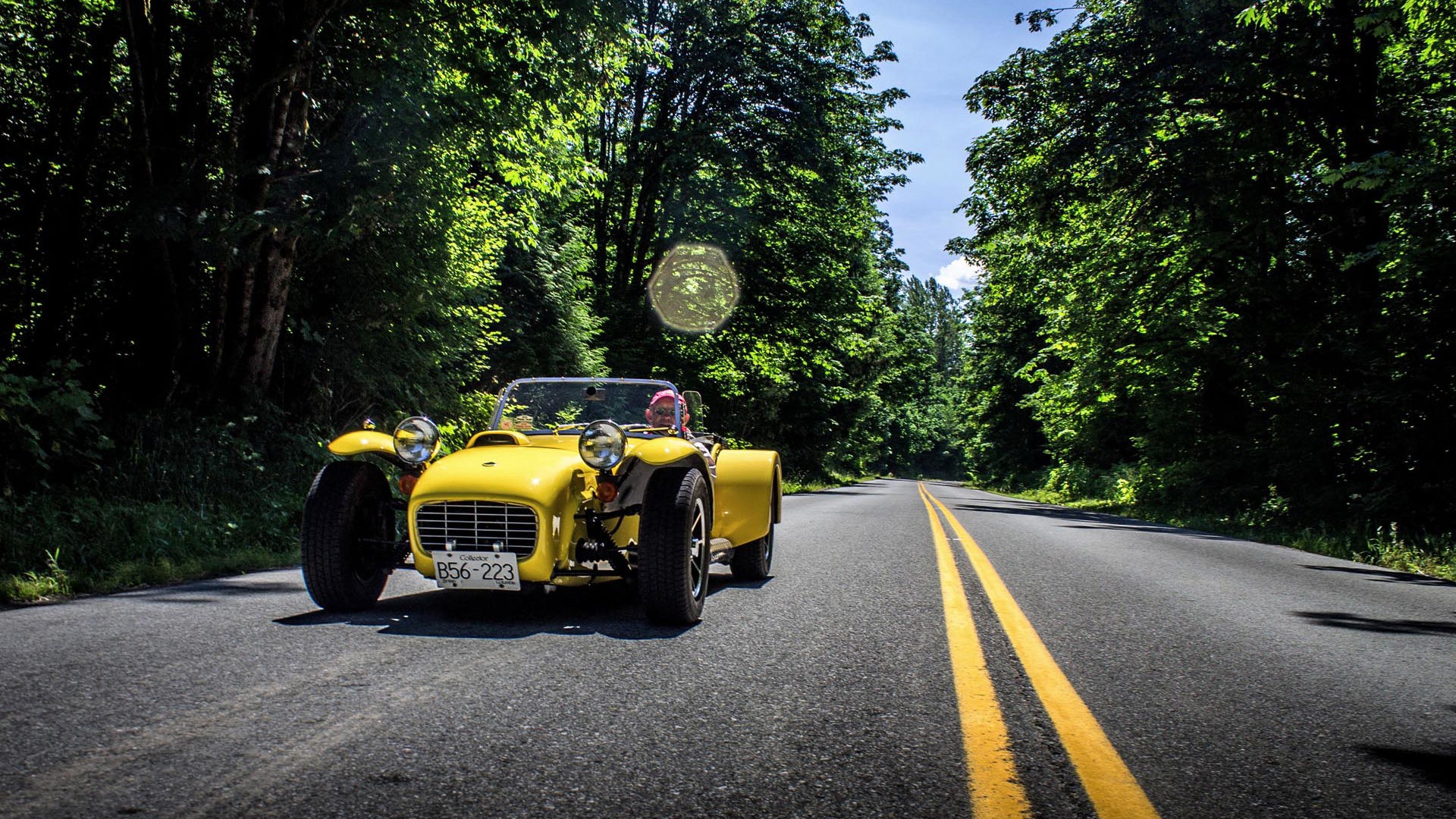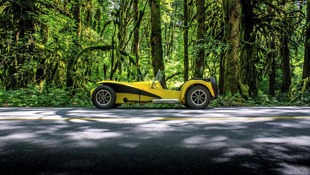There is a road that runs to nowhere, coursing underneath a leafy canopy, in a hurry without a destination. Beyond the trees, craggy mountains ring the valley, gazing down in impassive majesty.
They wear their fading snow like tattered rags, stone giants in ragged, shrinking finery. There are those who climb them, out touching the void, finding that there is little room on the peak for anything beyond what the senses can hold. No room for error. No room for the mundane. Nothing but the howl of the wind, the searing beauty of the landscape, and a heart full to bursting. It is the most elemental of pursuits.
We are as low to the earth as a skipped stone, but the feeling of soaring freedom is higher than the peaks that loom but cannot hem a soaring spirit in.
Down in the green valley, a similar asceticism, a paring away of layers until nothing but the core remains. A fragile aluminum hood flexes in the slipstream, the four-cylinder Kent crossflow rika-tik-tiks underneath it like a sewing machine. There are no doors, no roof, no respite from the sensation of speed. We are as low to the earth as a skipped stone, but the feeling of soaring freedom is higher than the peaks that loom but cannot hem a soaring spirit in.
Corner. My left foot comes off the footrest, a sliver of drilled aluminum the width of a medical bracelet, and dips down to hover over the clutch in anticipation. Brake, clutch-in, the merest sideways flex to tap the ribbon of steel serving as an accelerator, and the 84-horse 1.6L zings up in the rev range. Fourth to third is a mere wrist-flex for the absurdly stubby gear leaver, and then it's through the corner with the Escort-sourced live axle skipping over the rough stuff, the tiny three-spoke steering wheel chattering away excitedly.
“Give it some welly, lad!”
This is Driving. There are faster cars, more dangerous cars, purpose-built track specials and tarmac-crushing high-speed warriors. In a Lotus Super Seven, however, there is no room for anything but the drive. Conversations are shouted. If you've forgotten eye protection – as I have – you squint against a furious headwind. Modern compact cars look like semi-trailers. Semi-trailers look like escapees from the Mad Max prop department. It is a world of danger, raised heart rates, and forced sensation: simplify, and add methamphetamines.
God I love this thing. It's just distilled, cask-strength automobile. No pretense of luxury or even basic concessions to personal safety (we don't even have a roll bar), just the uisce beatha high-proof evaporate-off-your tongue essence of travelling far faster than human beings were ever meant to.
Perhaps something a little more practical: Mazda Miata Buyers Guide (1990-2015)
The car is a 1969 Lotus Super Seven, one of just 340 Series 3 cars built between '68 and '70. The shape will no doubt be familiar to many, but these factory-made cars are quite rare. This one was one of a handful delivered to a local dealer, and is entirely original from Dunlop wheels to paint.
It belongs to David Ellis, who is just the second owner. As compact and spare as his car, David hunted this car for some time before he got his hands on it. “It was just a little tired,” he said, “So I've gone through and refreshed a few things.” Most recently, that meant a gearbox rebuild, and today the little Seven is pulling like a lion. It feels happy, and that's perhaps not always the case with British machinery.
Back in the cockpit, my left nostril is doing a passable impression of the ram-air intake headlight of a Challenger Hellcat, forcing pure oxygen straight into my brain. My hat – peaked flat-cap, naturally – sits in a negative pressure zone, constantly threatening to raise off my head and go tumbling away behind us. When stopped, I can place my hand on the bare ground without leaning over much, always taking care not to scorch skin on the single side-pipe.
Woven vinyl seats offer no lateral support; they don't need to when your hips are hemmed in by transmission tunnel and the side of the car. Up front, the twin black caps of the headlights give the impression that you're riding piggyback on that insane, knife-wielding robot from Futurama.
The sideplate-sized steering wheel has little knurls under the back, and when it dances in your hand over a divot or a bump, it's like reading music in braille. The road varies between fresh pavement cruising and pothole-dodging, but this car is always gossiping away to you. There are whispers along a seam in the tarmac, shouts over the frost heaves; you go where your eyes lead – just think it and the Lotus is already turning.
At a feathery 500 kg, there's essentially no intertia to overcome, making the little Ford engine feel vital and hearty far above its modest power rating. These cars were originally designed as craft for an emerging interest in club racing, and that race-bred nimbleness and sharpness makes a backroad like this an absolute revelation.
To be frank, the over-engineered and heavily patrolled high-speed curves of the Sea-to-Sky bore me to tears in most machinery. There's just so little to do except watch the speedometer and/or set the cruise control.
In the Seven, however, it's like a Sopwith Camel making time towards a dogfight over the trenches. The wind, the sound, the rushing road so close you could touch it. A black-clad rider on a Ducati Corsa pulls alongside, gives us the thumbs up. You know what bikers call those stuck in cars, right? Cagers. Well, this thing ain't got no cage. At least that rider's got a helmet on.
David drives his Lotus regularly, even participating in long-distance runs. We ran in convoy with him on the Spring Thaw rally, for instance, and he's just back from a trip roaming around the forest roads near Mount St. Helens.
As he said to a Testarossa-driving onlooker who was all too eager to buy his Seven, “I'll never sell it. It's going to the grave with me, and then on to my son.” So far, this little yellow car has had just two owners, and good luck getting the current one to part with it.
Midpoint along the road to nowhere, we hop off at a spur to loop around and take a few pictures. And I do mean a few. Not only is the Seven somewhat difficult to jump in and out of, making shots on the fly difficult, but I simply don't want to stop driving it. My pale Irish skin is crisping in the sun, my eyes are streaming with the effects of being rammed full of pollen, and the constant roar of the wind has completely deafened my left ear.
More. More of this. On the way back home, we fall into line behind a second-generation Mazda Miata. Top-down, that car provides 90 percent of the thills, with about triple the civilization, and a much higher percentage of actually getting where you're going.
But that extra 10 percent of involvement that a Seven provides is worth the occasional discomfort or mechanical tantrum. It's like comparing a hike in the woods with scaling a peak; one is only a mild adventure, the other tests you to the limit.
The best thing about the Lotus Seven is that it transforms a road to nowhere into the path to enlightenment. The destination is the journey. There are no pointless drives.
This tiny car can't carry much, so you must leave it all behind. Out on the road, at speed beneath the trees, you find that a Lotus Seven still has room for everything you need.
